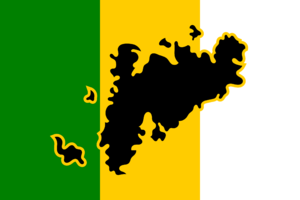Difference between revisions of "Hemeshi people"
Yrieixgroulx (talk | contribs) |
Yrieixgroulx (talk | contribs) |
||
| Line 57: | Line 57: | ||
==History== | ==History== | ||
===Prehistory=== | ===Prehistory=== | ||
During the Neolithic period and early Ekuosian Bronze Age, the Hemeshi Peninsula was inhabited by sedentary or semi-nomadic horticulturalists who lived primarily along the coast of the [[Gulf of | During the Neolithic period and early Ekuosian Bronze Age, the Hemeshi Peninsula was inhabited by sedentary or semi-nomadic horticulturalists who lived primarily along the coast of the [[Gulf of Ishenar]]. A period of increased rainfall around [[Argeyaz Bay]] beginning c. 900 BCE prompted a shift to more intensive agriculture and expansion into the drier regions of the peninsula's interior. The region returned to its drier baseline after 500 BCE, causing famine and instability in the Hemeshi peninsula, where primitive agricultural techniques were no match for the changing climate. Argeyazic tribes to the north, likely descendants of the [[Teset culture]], began expanding into the destabilized peninsula as their pastoral livelihood was well-suited to the deserts and steppes of the interior. Pre-Argeyazic peoples were largely assimilated or displaced to the wetter southern coast, eventually being absorbed entirely as the introduction of new crops and techniques led to the gradual adoption of agriculture by the early Hemeshi tribes. The first urban centers in the region emerged along the Ishenaar and Argeyaz coasts in subsequent centuries. | ||
===Kingdom of Hemesh=== | ===Kingdom of Hemesh=== | ||
Revision as of 00:39, 9 July 2018
 Pan-Hemeshi flag | |
| Regions with significant populations | |
|---|---|
| ? | |
| ? | |
| Template:Country data Adozia | ? |
| ? | |
| ? | |
| ? | |
| ? | |
| Template:Country data Gemet | ? |
| 4,213,000 | |
| Languages | |
| Hemeshi dialects | |
| Religion | |
| Iovism, Pashaism | |
| Related ethnic groups | |
| Algazi people | |
The Hemeshi people are an ethnicity or group of ethnicities originating from the Hemeshi Peninsula in western Ekuosia. Though historically regarded as one ethnic group, extensive regional variation and political fragmentation in the present-day have led to a number of distinctive national identities. Ethnic Hemeshis mostly speak various closely related dialects from the Peninsular branch of the Argeyazic language family, though heavy foreign presence in the region has led to many Hemeshis natively speaking other languages, such as Terminian or Neviran.
History
Prehistory
During the Neolithic period and early Ekuosian Bronze Age, the Hemeshi Peninsula was inhabited by sedentary or semi-nomadic horticulturalists who lived primarily along the coast of the Gulf of Ishenar. A period of increased rainfall around Argeyaz Bay beginning c. 900 BCE prompted a shift to more intensive agriculture and expansion into the drier regions of the peninsula's interior. The region returned to its drier baseline after 500 BCE, causing famine and instability in the Hemeshi peninsula, where primitive agricultural techniques were no match for the changing climate. Argeyazic tribes to the north, likely descendants of the Teset culture, began expanding into the destabilized peninsula as their pastoral livelihood was well-suited to the deserts and steppes of the interior. Pre-Argeyazic peoples were largely assimilated or displaced to the wetter southern coast, eventually being absorbed entirely as the introduction of new crops and techniques led to the gradual adoption of agriculture by the early Hemeshi tribes. The first urban centers in the region emerged along the Ishenaar and Argeyaz coasts in subsequent centuries.